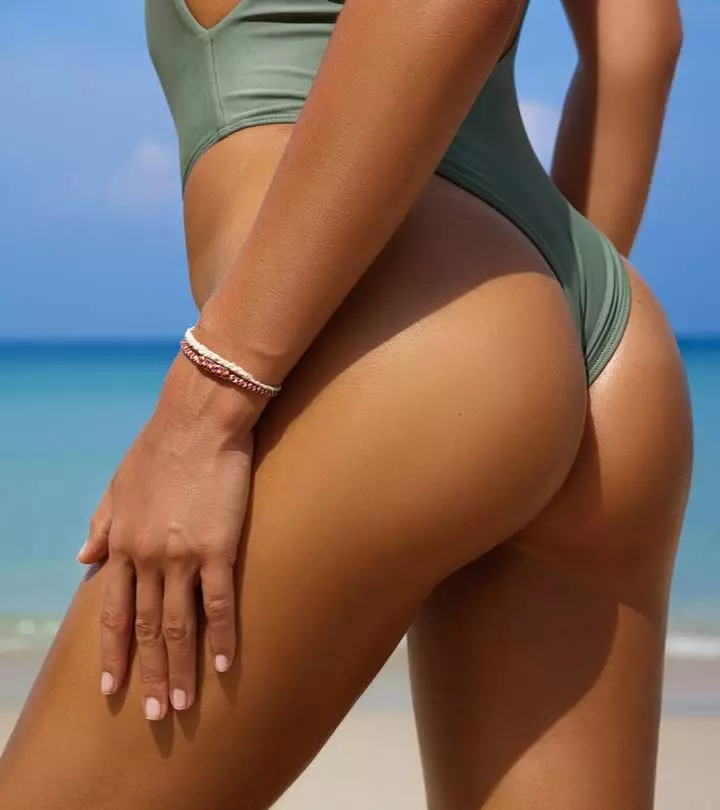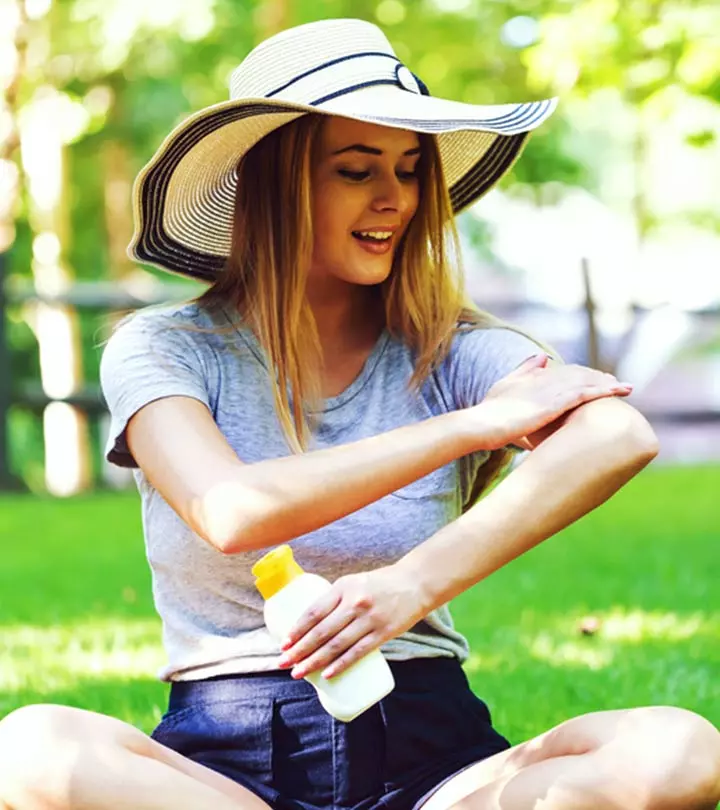Cutaneous Horn: Causes, Diagnosis, Risk Factors, & Treatment
While most of these overgrowths are benign, some may spell trouble.

Image: Shutterstock
A cutaneous horn is a skin growth caused by an overgrowth of keratin protein. It usually appears on the body and may grow a few millimeters or centimeters long. Most of the cutaneous horns are benign. However, some may be harmful and cancerous. This article explores the various aspects of cutaneous horns, their causes, risk factors, and treatment options. Read on to learn more.
In This Article
What Are Cutaneous Horns?
Cutaneous horns are uncommon lesions made of compact keratin. They resemble an animal’s horn. They can occur anywhere on the body but are mostly seen in sun-exposed areas like the face, ear, nose, forearms, and hands. Though 60% of the cutaneous horns are non-cancerous, some may turn cancerous, too (1).
 Trivia
TriviaHow do you recognize a cutaneous horn?
Key Takeaways
- Made of compact keratin, cutaneous horns are uncommon lesions that look like animal horns.
- Though these horns can appear anywhere in the body, they are primarily visible in areas exposed to the sun, like the face, ear, nose, forearms, and hands.
- These horns are not contagious, but about 40% of them can indicate Bowen’s disease or skin cancer.
How Does A Cutaneous Horn Look?

A cutaneous horn can appear in any shape and size, like a large bump, cone, thorn, or horn.
It is a horn-like growth on the skin and can be:
- White, tan, yellow, or brown
It can be of any shape:
- Cylindrical, conical, pointed, folded, or curved
It can occur on:
- Face, hands, ears, chest, arms, or nose
The base skin may get slightly thickened, and the horn can grow up to a few millimeters or centimeters. One may experience pain and infection if the horn is damaged.
These horns may indicate an underlying condition. But why do they occur on the body? What causes cutaneous horns?
Causes Of Cutaneous Horns

- Although the exact cause of cutaneous horns is unknown, it is believed to develop from excessive keratin on the skin. In addition, cellular aging and photodamage are also assumed to cause cutaneous horns (2).
- Sun exposure and old age are observed as the most common comorbiditiesi A clinical term referring to other medical conditions that generally exist simultaneously in the presence of a particular disease. in cases of cutaneous horns (2).
- Both men and women can develop cutaneous horns. However, men are more likely to develop a cancerous horn (3).
- Although not established, people with fairer skin may have more chances of developing cutaneous horns (2).
- Cutaneous horns are often benign. But they can be cancerous too. For example, they could occur due to squamous cell carcinoma (skin cancer developing in the cells in the middle and outer skin layers) or basal cell carcinoma (cancer that grows on the skin areas exposed to the sun).
 Did You Know?
Did You Know?There are a few risk factors associated with cutaneous horns. We will discuss them in the next section.
Risk Factors Of Cutaneous Horns

Cutaneous horns are not contagious. However, about 40% of the horns may be harmful and indicate Bowen’s disease or skin cancer (4). Hence, you must consult a physician when they first appear.
Common symptoms seen in cancerous horns are:
- Pain around the affected area
- Redness or bleeding
- Thickening at the base of the horn•
- Growth at a rapid pace
Cutaneous horns on the upper regions of the face and ears are more commonly associated with malignancy (1). Also, lesions with a wider base are more likely to be cancerous (2).
How can you know for sure if the horn is cancerous? Consulting a dermatology expert can help in diagnosing the lesion.
Diagnosis Of A Cutaneous Horn

Cutaneous horns are mostly examined by their clinical appearance. However, the risk of skin cancer warrants an excision and histological histological examinationi The detailed study of body cells extracted from an affected area under a microscope to diagnose a disease, such as cancer. to determine if the horn is cancerous. Your doctor may suggest a biopsy test for the same. The entire horn is removed during a biopsy and sent for additional pathology tests to determine the right treatment options.
We will look into these treatment options in the next section.
Treatment For A Cutaneous Horn
The most chosen treatment is the removal of the horn, which can be carried out:
- Surgically
- Medically
- Via laser ablationi A laser surgery that uses a light beam to remove or destroy unwanted lesions or cancerous growths from the body.
However, the type of treatment will also depend on the type of growth.
If the cutaneous horns are non-cancerous, treatment may include:
- Removing or excising the horns from the base
- Freezing the lesion with liquid nitrogen
- Burning the growth with laser
If the cutaneous horns are cancerous, treatment may include:
- Radiation therapy
- Chemotherapy
- Topical medicines to improve the immune system
Cutaneous horns may reappear or grow back even after removal. But following measures may help prevent their recurrence. Regular skin checks and follow-up appointments are important after the removal of cutaneous horns. These practices help in the early detection of any recurrences or new growths. Remember to monitor your skin closely and report any changes to your healthcare provider timely. Following their advice on care can help maintain your skin’s health and prevent future complications.
Reducing The Risk Of Cutaneous Horns

- Decrease your sun exposure.
- Wear sun-protective clothing.
- Always wear sunscreen before stepping out in the sun.
- Avoid indulging in outdoor activities between 10 AM and 4 PM when the ultraviolet radiation could be at its peak (5).
- Perform self-skin checks and look for any uncommon growths on the skin.
Infographic: All You Need To Know About Cutaneous Horns
Cutaneous horns are rare skin growths that resemble small animal horns. While they are usually benign, some may be cancerous and cause distress due to their appearance. So, what causes these growths and how can they be prevented? Check out this infographic now to know more!

Illustration: StyleCraze Design Team
Cutaneous horns are skin projections that are conical in shape. They form due to an overabundance of keratin, a protein that also forms the nails and hair. Cutaneous horns are more common in older people and usually form on sun-exposed body areas. They can be malignant, precancerous, or benign. Therefore, consult a doctor for a biopsy on a cutaneous horn to assess whether it is benign or potentially dangerous before destroying it. Even after removal, cutaneous horns might return or grow again. However, the suggestions in the article may aid in preventing recurrence.
Frequently Asked Questions
How common is a cutaneous horn?
A cutaneous horn is commonly observed in elderly individuals between 60 and 80. Both males and females develop cutaneous horns in the neck, head, and upper extremities (2).
Is cutaneous horn life-threatening?
Cutaneous horns may occasionally be an indication of skin cancer. Cutaneous horns are mostly benign lesions; however, studies show that nearly one-third of them can turn out to be malignant skin lesions (1).
Do cutaneous horns grow with age?
Yes, they do, but not in all cases. Anecdotal evidence suggest that the rate of their growth and size can differ from person to person, and that can be affected by a number of factors, including heredity, sun exposure, and underlying skin problems.
Watch this video to learn about the Lotus laser treatment for cutaneous horns. Discover how this revolutionary treatment can help you achieve smoother, healthier skin.
References
Articles on StyleCraze are backed by verified information from peer-reviewed and academic research papers, reputed organizations, research institutions, and medical associations to ensure accuracy and relevance. Read our editorial policy to learn more.
- Cutaneous horn: A mask to underlying malignancy
https://www.ncbi.nlm.nih.gov/pmc/articles/PMC5824527/ - Cutaneous Horn
https://www.ncbi.nlm.nih.gov/books/NBK563280/ - A histopathological study of 643 cutaneous horns
https://pubmed.ncbi.nlm.nih.gov/2039721/ - Cutaneous Horn Malignant Melanoma
https://www.ncbi.nlm.nih.gov/labs/pmc/articles/PMC4209709/ - UV Radiation And The Skin
https://www.ncbi.nlm.nih.gov/pmc/articles/PMC3709783/
Read full bio of Dr Ashok Gund
Read full bio of Swathi E
Read full bio of Anjali Sayee
Read full bio of Monomita Chakraborty


























Community Experiences
Join the conversation and become a part of our empowering community! Share your stories, experiences, and insights to connect with other beauty, lifestyle, and health enthusiasts.